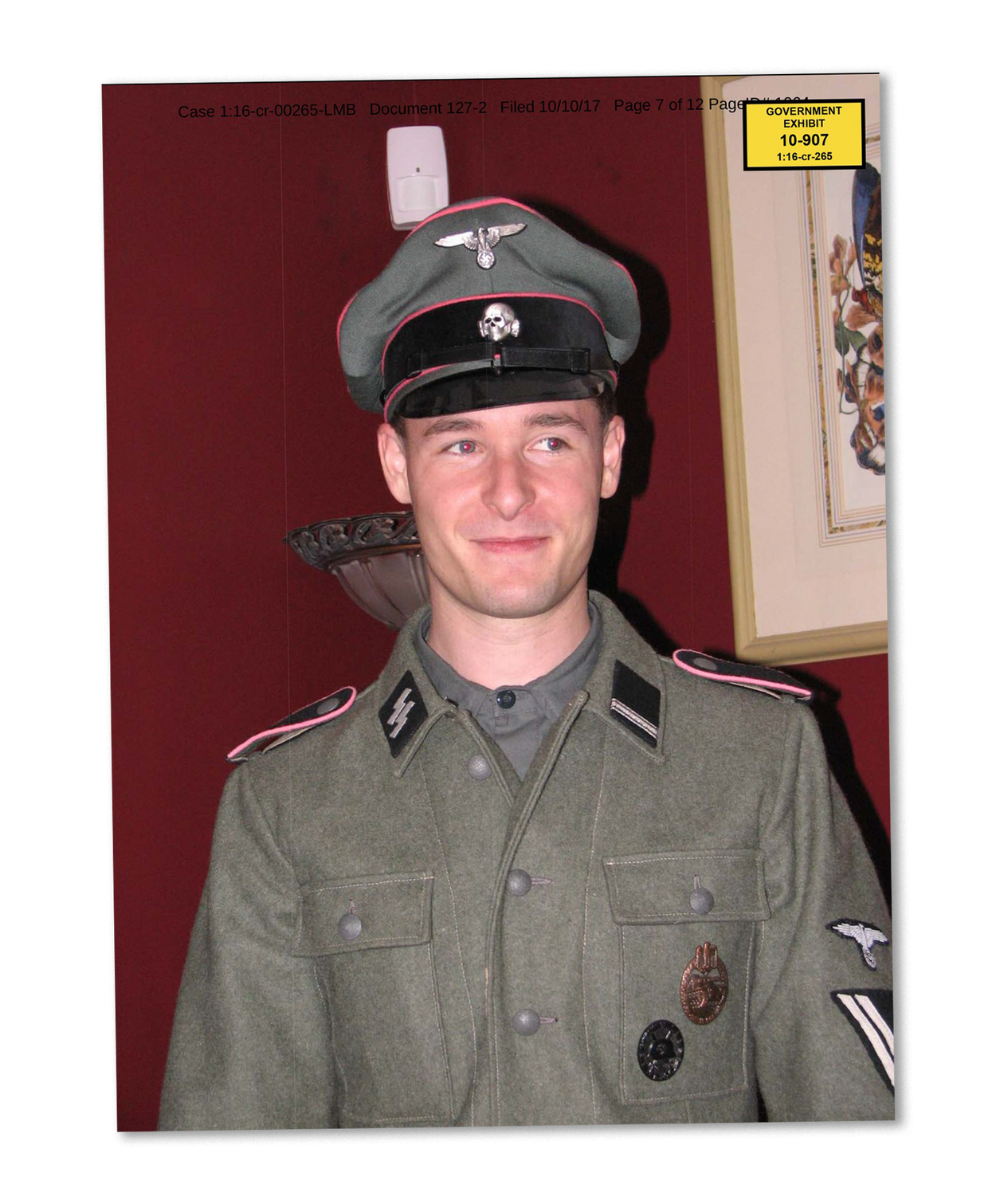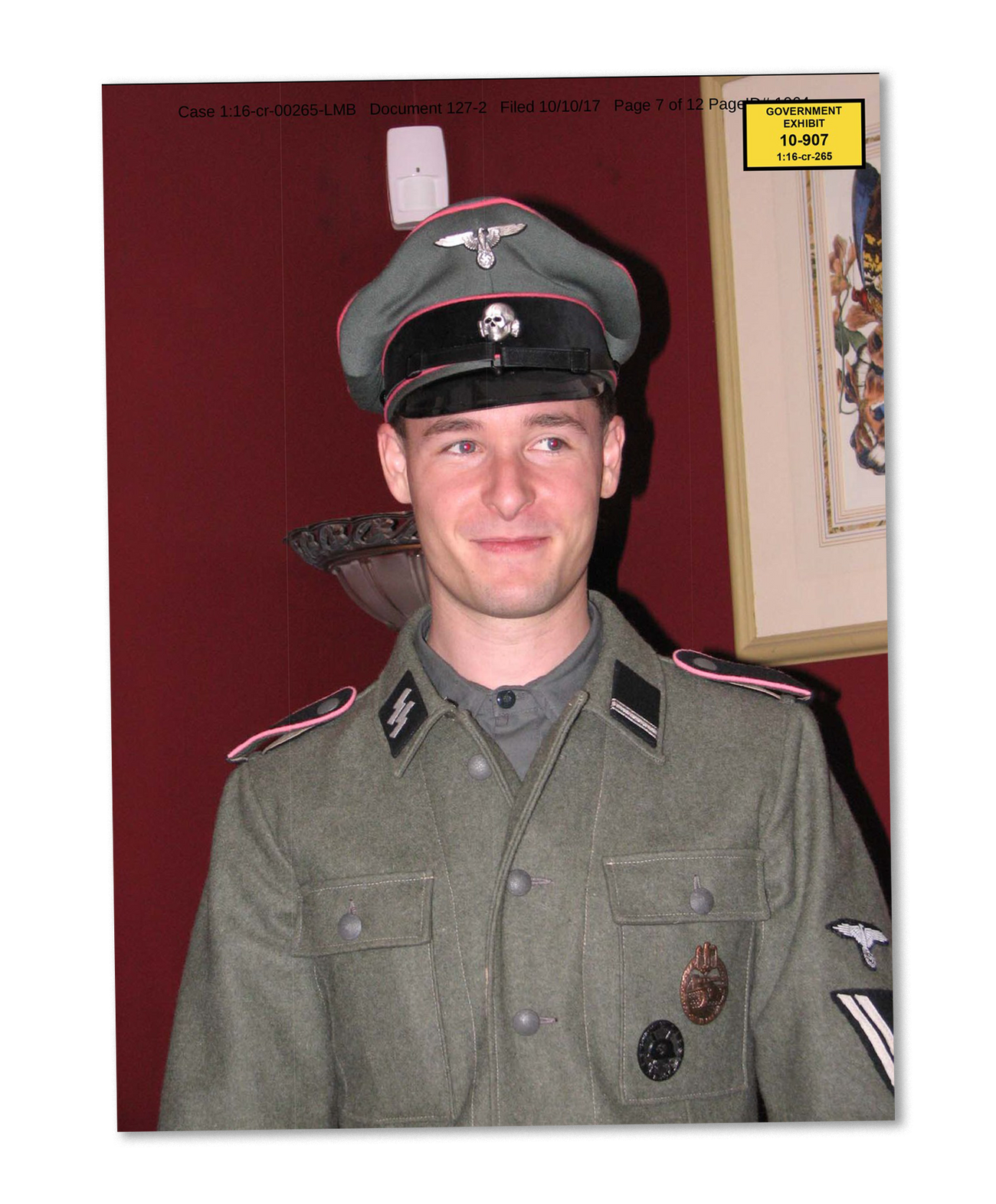Intersectional Antisemitism in America
The internet has brought jihadists, neo-Nazis, and anarchists together through their shared hatred of Jews




Nicholas Young, a District of Columbia Metro Transit Police officer, was a fixture in the local D.C. neo-Nazi scene in the early 2000s. Sporting an SS tattoo on his arm, he collected German World War II memorabilia and attended parties in full Nazi uniform with like-minded Reich enthusiasts. But at some point Young also became interested in Islamism, eventually converting to Islam and spiraling down a rabbit hole of jihadist websites while never abandoning his Nazi sympathies. He soon caught the attention of the FBI, which targeted him in a sting operation that led to his arrest in 2016 for attempting to provide support to ISIS. He was convicted and sentenced to 15 years in prison.
The Nazi-Islamist nexus may seem like a strange one, but Young was ahead of his time—a forerunner of “intersectional antisemitism,” one of the key dynamics characterizing today’s highly complex forms of extremism. Antisemitism is now the conspiratorial glue that binds the many disparate ideologies that poison America’s increasingly polarized society. Because of social media, which allows for an unprecedented degree of interconnectivity between extremists of all stripes, antisemitic tropes, texts and memes are shared across ideological milieus. New crises like COVID-19 or the war in Ukraine provide additional ammunition for cross-ideological, antisemitic propaganda to spread and grow. In this environment, it is not uncommon to see neo-Nazis root for Hamas whenever tensions in the Gaza Strip arise and Islamists praise white supremacists when they attack synagogues.
The belief that Jews are unique agents of evil, secretly manipulating world events is the common denominator in virtually all forms of extremism present in America today. It is not entirely a new phenomenon, as cross-ideological pollination of antisemitism is a centuries-old cancer. But because of the web, we have fully entered the era of intersectional antisemitism.
At these intersecting ideologies of antisemitic vitriol, Young was easily able to synthesize neo-Nazism and jihadism. In his house, investigators found a handwritten prayer for “Hitler, Skorzeny, Hajj Amin al-Hussaini, Mussolini, Saddam Hussein, Prophet Muhamed, John the Baptist & all the Companions.” Otto Skorzeny was an Austrian colonel in the Waffen-SS who later fled to Egypt, where he trained Palestinian paramilitary forces (with Yasser Arafat counted among his trainees) to conduct raids into Israel. Haj Amin al-Husseini was the emir of Jerusalem who sought a political alliance with the Nazis in the hopes of eliminating the Jewish presence in British-controlled Palestine. In addition to the prayer, Young had a poster in his room titled “The Alliance: Worldwide Association of Nazis and Islamists 1939-2004,” and the password to the Gmail account he used to contact ISIS members was Adolf Hitler’s birthday.
In recent years, the largest terrorist attacks against American Jews have come from the extreme right. The majority of these right-wing extremists, the FBI reports, do not belong to any structured movement but operate as freelancers. Such were the lone shooters who stormed Pittsburgh’s Tree of Life synagogue in 2018 and the Chabad of Poway synagogue in 2019.
But even when their targets are not Jews, Jews are often on the mind of America’s militant right-wing extremists. The individuals who carried out the attacks in El Paso in 2019 and Buffalo in 2022, which openly targeted Latinos and Blacks, respectively, left behind manifestos that spoke about Jews. Like many others in their ideological milieu, they embraced the so-called great replacement theory that depicts Jews as the sinister masterminds of a plot to replace white people in Western nations with other ethnic groups.
The belief that Jews are unique agents of evil, secretly manipulating world events, is the common denominator in virtually all forms of extremism present in America today.
Like the right-wing militants who take inspiration from jihadist attacks on Jews, American Islamists are equally interested in right-wing extremism. That was the case of Muslim convert Damon Joseph, who was sentenced to 20 years in prison for planning attacks against two synagogues in the Toledo, Ohio, area. “In a matter of months, Damon Joseph progressed from a self-radicalized, virtual jihadist to planning an actual attack on fellow Americans,” the FBI wrote. Joseph was inspired by the attack against the Tree of Life synagogue despite the fact that the shooter was not an Islamist but a right-wing militant. Joseph went on to publish an antisemitic manifesto and shared statements expressing his desire to die a martyr.
Many jihadists in America are drawn to the Islamic State and al-Qaida, but networks linked to the Muslim Brotherhood and Hamas have also created a broad web of organizations, mosques and schools where antisemitic rhetoric is common. Most of the antisemitism of this milieu takes typically Islamist undertones, as when the imam of Jersey City’s Islamic Center called Jews “apes and pigs” and urged his followers to “count them one by one, and kill them down to the very last one. Do not leave a single one on the face of the earth.”
But at times American Islamists borrow straight from other forms of antisemitism. It’s a phenomenon that dates back decades. In the early 1990s, the now-defunct Islamic Association of Palestine, a Chicago-based organization linked to Hamas, published America’s Greatest Enemy: The Jew! And an Unholy Alliance!, a 32-page screed that reprints various antisemitic essays. The first article in the collection argues that “Blacks are still begging for crumbs” while “the Jews through their Zionist machinery have power over all the agencies and organs of the United States government.” Another article reproduces a speech by Austin J. App, a Nazi apologist and Holocaust denier. App delves into classic denial theories, arguing that “the German concentration camps were internment and work camps, never, absolutely never, death camps.” Published by an Islamist entity and containing writings by Black supremacists and neo-Nazis, America’s Greatest Enemy is a perfect archetype of intersectional antisemitism. Similar texts are now widely available online.
Antisemitism is also a feature of various extremist ideologies within the African American community. The Black Hebrew Israelite (BHI) movement, for instance, which recently dominated the news in the wake of several scandals involving Kanye West and Kyrie Irving, believe that modern-day African Americans are the real descendants of the biblical Israelites and that white Jews are impostors. Moreover, some BHIs argue that Jews controlled the slave trade and that Jews “invented” the Holocaust as a hoax to distract from another genocide targeting African Americans. A fringe group that traditionally limited its activism mostly to colorful street demonstrations, BHIs have in recent years utilized the internet to disseminate their views to a much broader audience.
Some of the group’s supporters have also carried out a slew of deadly attacks against Jews. The two most notable of a long list of incidents took place in the New York metropolitan area in December 2019. In the first, two BHI followers engaged in a crime spree against Jews and cops that culminated with a mass shooting at a kosher supermarket in Jersey City, where three people and the two attackers were killed. Two weeks later, a masked man heavily influenced by BHI propaganda attacked a Hannukah party in Monsey, injuring four and killing one.
Some of the very same narratives that are common among white supremacists and Islamists have become increasingly popular within far left and anarchist milieus, though it’s rare to find people in these communities openly embracing the antisemitic character of their politics the way Islamists and those on the far right do. More often, left-wing antisemites claim to be acting in the name of progressive principles while espousing the same trite tropes that depict Jews as embodiments of soulless capitalism, colonialism (Israel is cast as the last colonial state), and white privilege.
It is true that left-wing extremists have not targeted Jews with terrorist attacks the way their far right and Islamist counterparts have. But over the last few years episodes of violence that occurred at anti-Israel events organized by far-left and Palestinian groups have grown in frequency, such as the attacks that took place during two pro-Israel events on visibly Jewish passersby in New York and Los Angeles who had no involvement in the protests themselves. The increasingly antisemitic and threatening nature of anti-Israel activities on college campuses—most recently exemplified by a rally at the University of Michigan where protesters held a sign saying, “There is only one solution” and screamed “intifada”—do not bode well for the future.
Finally, antisemitism is also a defining feature of the latest development in American extremism, the growing trend that sees disturbed and violent-prone individuals cherry picking elements of various extremist ideologies to rationalize their actions—a phenomenon authorities call “salad bar extremism.” A textbook example is that of Ethan Melzer, an active-duty member of the U.S. Army who in June 2022 pleaded guilty to various terrorism-related charges. Melzer was also a member of the Order of Nine Angles (O9A), a U.K.-based occultist group whose members, according to U.S. authorities, “have espoused violent, neo-Nazi, antisemitic, and Satanic beliefs, and have expressed admiration for, among others, Nazis, such as Adolf Hitler, and Islamic jihadists, such as Usama Bin Laden.” The government also noted that “hatred of Jews was a unifying belief for members of the conspiracy and they regularly expressed anti-Semitic sentiments to foster trust and cohesiveness.” Melzer spoke about killing Jews and “turning israel and their ppls to dust inshallah and imposing fashy [fascist] shariah” while regularly praising Hitler.
In this climate, it is not surprising that, in 2019, 60% of all religiously motivated hate crimes were against Jews. The federal government, law enforcement agencies, and Jewish communities throughout the country understand the problem, and know that there is no easy fix. A good place to start would be with large-scale educational efforts: A 2020 national survey of millennials and Generation Z showed that 63% did not know that 6 million Jews were murdered in the Holocaust. We also need to see enhanced security protecting Jewish targets, and increased focus on the antisemitic content that is tolerated by social media platforms. These endeavors are necessary to begin to stem the tide of the growing American problem of intersectional antisemitism.
Lorenzo Vidino is the director of the Program on Extremism at The George Washington University.